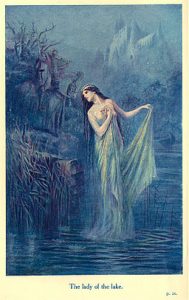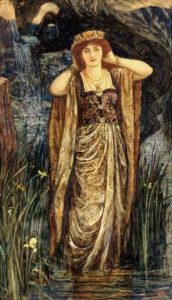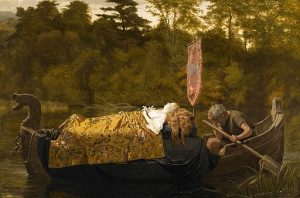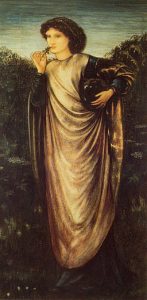The legend of King Arthur often invokes to mind knights fighting in battles or embarking on long and dangerous quests. However, the legends also contain some crucial female characters who despite being few in number, provide the stories with new themes such as magic and forbidden love. Although female characters in Arthurian legend are often overlooked, the roles they play have helped to make these stories memorable and timeless.
The Lady of the Lake (also known as Nimue and Vivien) is a key figure at the beginning of Arthurian legend, as she is the one who provides Arthur with his renowned sword, Excalibur. Arthur has to row across her lake and take the sword from her outstretched hand in the water. When Arthur dies, he orders Excalibur to be thrown back into a river, where the same hand reaches out to take the sword back. In some French Arthurian legends, the Lady of the Lake is the guardian of the famous knight Lancelot and uses her magical powers to aid him in times of need. Under the names of Nimue and Vivien, she is also known for her seduction of the wizard Merlin; she traps him in a tree for eternity after he teaches her magic. With her many names and roles, the Lady of the Lake is perhaps the most ambiguous female character in Arthurian legend.
Next is Guinevere, one of the most famous and infamous characters in Arthurian legend. The wife of King Arthur but also the lover of his best knight Lancelot, she is often credited with causing the downfall of the Arthurian kingdom as her exposed affair incites a civil war between Arthur and Lancelot’s factions. The portrayals of Guinevere in legend vary by author; some paint her as jealous and controlling of Lancelot by showing her fury when he spends time with other women. Other authors are more sympathetic, noting her kindness towards Lancelot (she returns his missing sword to him after he is first knighted so he doesn’t embarrass himself in court) and her conflicting feelings towards her husband and lover. It is poignant that Guinevere refuses to marry Lancelot after Arthur dies; she instead spends the rest of her days in a nunnery where she repents her role in the downfall of the Arthurian kingdom.
Elaine of Astolat has one of the most moving stories in Arthurian legend. Elaine helps to nurse Lancelot back to health when he arrives at her father’s castle after being seriously injured in a tournament. She quickly develops strong feelings for Lancelot, but he doesn’t notice as he is still madly in love with Guinevere. Once he has healed and left the castle, Elaine dies from a broken heart. Her body is placed in a boat and drifts down the river to King Arthur’s court in Camelot. A letter in her hand explains the pain of her unrequited love, and even Guinevere tells Lancelot that he should have been kinder to her. This short but tender piece of Arthurian legend has inspired many revisions of the story, including Pre-Raphaelite art and Tennyson’s poem ‘The Lady of Shalott.’
Last but certainly not least is Morgan le Fay. Although she is Arthur’s half-sister, her penchant for mischief makes her completely different from the King. Some legends claim that she was raised in a nunnery where (paradoxically) she learned the art of magic. Morgan frequently tries to disrupt the harmony of Arthur’s kingdom; she throws his scabbard that prevents him from being wounded into a lake and even sends him an enchanted mantel that would have killed him had he put it on. She also tries to expose Lancelot and Guinevere’s affair by making a shield with a picture of Lancelot standing on Arthur and Guinevere’s shoulders. Despite all the chaos she causes, Morgan accompanies Arthur on his boat to the magical land of Avalon after he dies. The legend says that she will heal him there so he can one day return to Britain when its people need him. With an ability for both extreme good and evil, Morgan le Fay is arguably Arthurian legend’s most complex woman.
All these women have unique characteristics and are instrumental to the main storylines in Arthurian legend. However, with the exception of Elaine, they all have questionable codes of morality, whether that be due to adultery or dark magic. As a result, they are different from the two-dimensional female characters seen in other legends as they all demonstrate their own agency. Even though these women are not as glorified as the knights, they have clearly played a large part in the continued modern-day interest in Arthurian legend.




